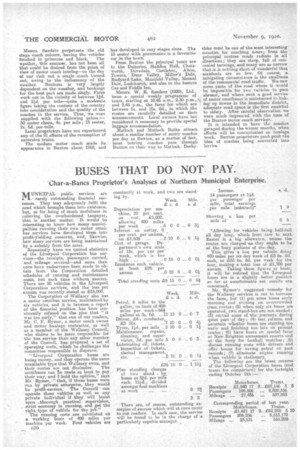BUSES THAT DO NOTPAY.
Page 54

If you've noticed an error in this article please click here to report it so we can fix it.
Char-a-I3ancs Proprietor's Analyses of Northern Municipal Enterprise.
MIINICrPAL public services are .1.Y1-rarely outstanding financial succesaes. They may adequately fulfil the need which brought them into existence, but, as for being of mneb usefulness in relieving the overburdened taxpayer, that is another matter. It would be interesting to know how many municipalities running their own motor omnibus services have developed them into profit-yielding concerns, and, likewise, how many services are being maintained by a subsidy from the rates.
Repeatedly have we quoted statistics of the Liverpool Corporation bus services—the receipts, passengers carried, • and mileage covered—and more than once have endeavours been made to obtain from the Dorporation detailed schedules of running and maintenance costa, but each time without success. There are 50 vehieles in the Liverpool Corporation services, and the loss per annum was recently stated as £15,000. The Corporation of-Wallasey also has a motor omnibus service maintained by six vehicles, and it is amuse a report of the financial position liAR been consistently refused on the pjea that "it was too early," that one of our readers, Mr. C. F. Rymer, a motor coach owner and motor haulage contractor, as well as a member of the Wallasey Council, who claims to be more responsible for the bus service than any other member of the Council, has prepared a set of operating costs, which he challenges the committee responsible to disprove. " Liverpool Corporation buses are losing money, and they operate the same unsuitable type that Wallasey owns, and their routes are not dissimilar. The omnibuses can be made at least to pay their way, and I hold the opinion," says Mr. Rymer, "that; if these buses were run by private enterprise, they would be profit-earners. The Council can operate these vehicles as well as any private individual if they will insist upon -thorough practical supervision, strict economy in running, and get the right type of vehicle for the job."
The running costs are calculated on a working basis of 400 miles per machine per week. Four vehicles are
C30 constantly at work, and two are standing by. Week. Mile.
s. d. s. el.
Depreciation per machine, 20 per cent. on cost. 21,600, allowing 400 miles per week ...6 0 0 ... 0 Interest on outlay, 8 per cent, per annum,
on 21,600 ...2 10 0 ... 0 14 Cost of garage. Department' s own scale of 15s, per car per week, whichis too
high ... 0 15 0 ... 0 04 Insurance each vehicle, at least 226 per annum .. ...0 10 0 ... 0 01
There are, of COLITEae, outstanding examples of success which will at once occurto our readers. In each case, the service will be found to he in the charge of a
particularly Capable manager., .
*Allowing for vehicles being half-full. all day long, which from now to next, Easter is a big allowance, unless theroutes are charged as they ought to be at the busy portions of the day.
This gives a loss per vehicle doing 400 miles per six-day week of 28 68. 8d. each, or -C33 5s. 80. per week for the four, making a total loss of 21,700 per annum. Taking these figures as basic, it will be noticed that the Liverpool buses are in a slightly better position so far as ascertainable net results are concerned.
Mr. Rymer's suggested remedy for the Wallasey services is not to increase the fares, but (1) put some buses early morning and evening on overcrowded tram routes; -(2) when only six buses are operated, two. stand-bys are not needed ; (3) curtail some of the journeys during quiet part of day; (4) test returns arid ascertain whether buses are starting too early and finishing too late on present routes; (5) have buses on special fares at New Brighton amusement resorts and at the ferry for football matches; (6) discuss running costs with drivers and offer bonus for saving petrol on past records; (7) eliminate engine runniqg when vehicle is stationary.
The following are the latest returns of the Liverpool Corporation buses (and trams for comparison) for the fortnight ending October 9th


























































